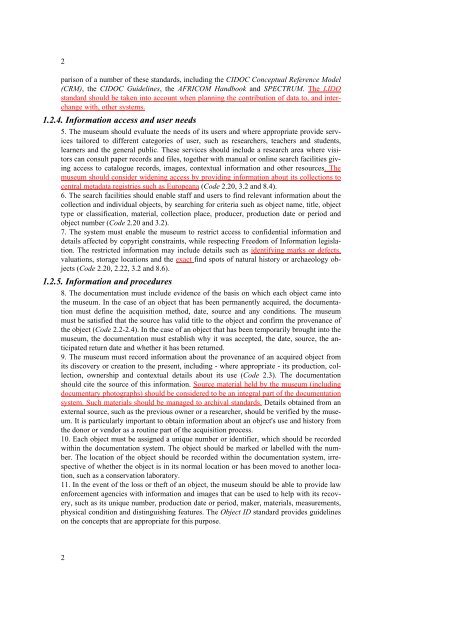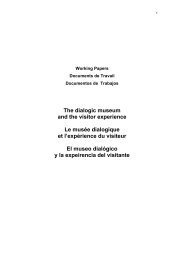1. Statement of principles of museum documenta - The International ...
1. Statement of principles of museum documenta - The International ...
1. Statement of principles of museum documenta - The International ...
You also want an ePaper? Increase the reach of your titles
YUMPU automatically turns print PDFs into web optimized ePapers that Google loves.
2<br />
parison <strong>of</strong> a number <strong>of</strong> these standards, including the CIDOC Conceptual Reference Model<br />
(CRM), the CIDOC Guidelines, the AFRICOM Handbook and SPECTRUM. <strong>The</strong> LIDO<br />
standard should be taken into account when planning the contribution <strong>of</strong> data to, and interchange<br />
with, other systems.<br />
<strong>1.</strong>2.4. Information access and user needs<br />
5. <strong>The</strong> <strong>museum</strong> should evaluate the needs <strong>of</strong> its users and where appropriate provide services<br />
tailored to different categories <strong>of</strong> user, such as researchers, teachers and students,<br />
learners and the general public. <strong>The</strong>se services should include a research area where visitors<br />
can consult paper records and files, together with manual or online search facilities giving<br />
access to catalogue records, images, contextual information and other resources. <strong>The</strong><br />
<strong>museum</strong> should consider widening access by providing information about its collections to<br />
central metadata registries such as Europeana (Code 2.20, 3.2 and 8.4).<br />
6. <strong>The</strong> search facilities should enable staff and users to find relevant information about the<br />
collection and individual objects, by searching for criteria such as object name, title, object<br />
type or classification, material, collection place, producer, production date or period and<br />
object number (Code 2.20 and 3.2).<br />
7. <strong>The</strong> system must enable the <strong>museum</strong> to restrict access to confidential information and<br />
details affected by copyright constraints, while respecting Freedom <strong>of</strong> Information legislation.<br />
<strong>The</strong> restricted information may include details such as identifying marks or defects,<br />
valuations, storage locations and the exact find spots <strong>of</strong> natural history or archaeology objects<br />
(Code 2.20, 2.22, 3.2 and 8.6).<br />
<strong>1.</strong>2.5. Information and procedures<br />
8. <strong>The</strong> <strong>documenta</strong>tion must include evidence <strong>of</strong> the basis on which each object came into<br />
the <strong>museum</strong>. In the case <strong>of</strong> an object that has been permanently acquired, the <strong>documenta</strong>tion<br />
must define the acquisition method, date, source and any conditions. <strong>The</strong> <strong>museum</strong><br />
must be satisfied that the source has valid title to the object and confirm the provenance <strong>of</strong><br />
the object (Code 2.2-2.4). In the case <strong>of</strong> an object that has been temporarily brought into the<br />
<strong>museum</strong>, the <strong>documenta</strong>tion must establish why it was accepted, the date, source, the anticipated<br />
return date and whether it has been returned.<br />
9. <strong>The</strong> <strong>museum</strong> must record information about the provenance <strong>of</strong> an acquired object from<br />
its discovery or creation to the present, including - where appropriate - its production, collection,<br />
ownership and contextual details about its use (Code 2.3). <strong>The</strong> <strong>documenta</strong>tion<br />
should cite the source <strong>of</strong> this information. Source material held by the <strong>museum</strong> (including<br />
<strong>documenta</strong>ry photographs) should be considered to be an integral part <strong>of</strong> the <strong>documenta</strong>tion<br />
system. Such materials should be managed to archival standards. Details obtained from an<br />
external source, such as the previous owner or a researcher, should be verified by the <strong>museum</strong>.<br />
It is particularly important to obtain information about an object's use and history from<br />
the donor or vendor as a routine part <strong>of</strong> the acquisition process.<br />
10. Each object must be assigned a unique number or identifier, which should be recorded<br />
within the <strong>documenta</strong>tion system. <strong>The</strong> object should be marked or labelled with the number.<br />
<strong>The</strong> location <strong>of</strong> the object should be recorded within the <strong>documenta</strong>tion system, irrespective<br />
<strong>of</strong> whether the object is in its normal location or has been moved to another location,<br />
such as a conservation laboratory.<br />
1<strong>1.</strong> In the event <strong>of</strong> the loss or theft <strong>of</strong> an object, the <strong>museum</strong> should be able to provide law<br />
enforcement agencies with information and images that can be used to help with its recovery,<br />
such as its unique number, production date or period, maker, materials, measurements,<br />
physical condition and distinguishing features. <strong>The</strong> Object ID standard provides guidelines<br />
on the concepts that are appropriate for this purpose.<br />
2



